We spent three months traveling all around Europe using trains from Portugal to Italy, Slovenia, the Czech Republic, Germany, and more! Throughout our time in Europe we traveled exclusively by train. While having a car gives you some freedom, we visited so many beautiful places without worrying about navigating small streets or parking in tiny spots and really enjoyed having that flexibility. Here are our top tips for taking trains in Europe so you know exactly what to expect!
Disclosure: This post contains Amazon affiliate links. As an Amazon Associate we earn from qualifying purchases. This means at no additional cost to you, we will earn a commission if you click through a link and make a purchase. This post may also contain other affiliate links and non-affiliate links to products and websites.
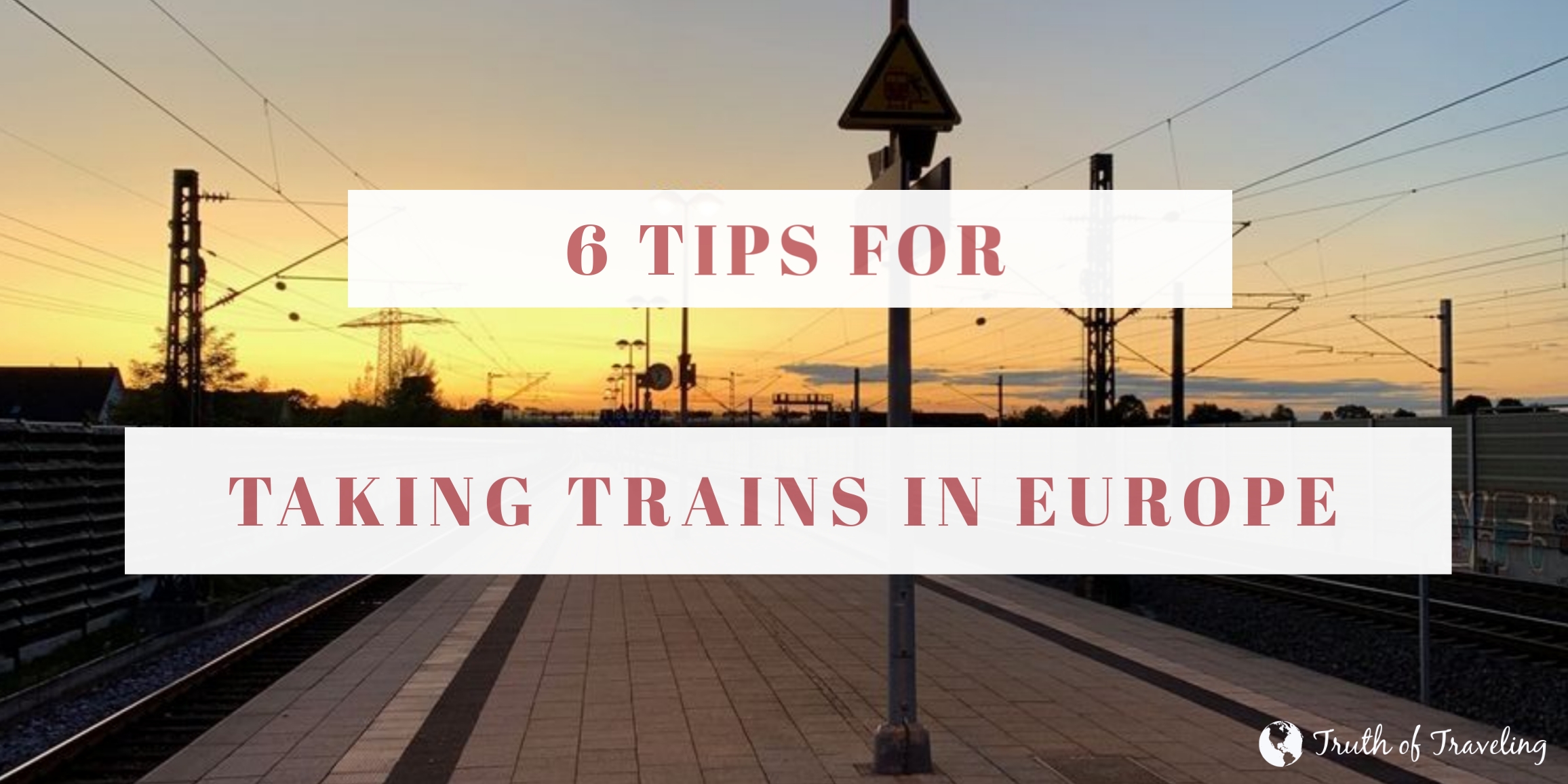
How do I Buy Train Tickets in Europe?
The trains in each country are usually operated by one or two companies. For example, in Italy the trains are operated by Trenitalia while in France it’s primarily SNCF. You can buy tickets directly through the train operators website for each country or you can also buy tickets at the train station.
We traveled with the 3 month Eurail Global Pass which means we could ride unlimited trains for 3 months. We chose 3 months because that’s how long we spent in Europe. With the Eurail Pass we simply got on a train, wrote down the train journey on our pass and showed the conductor when prompted.
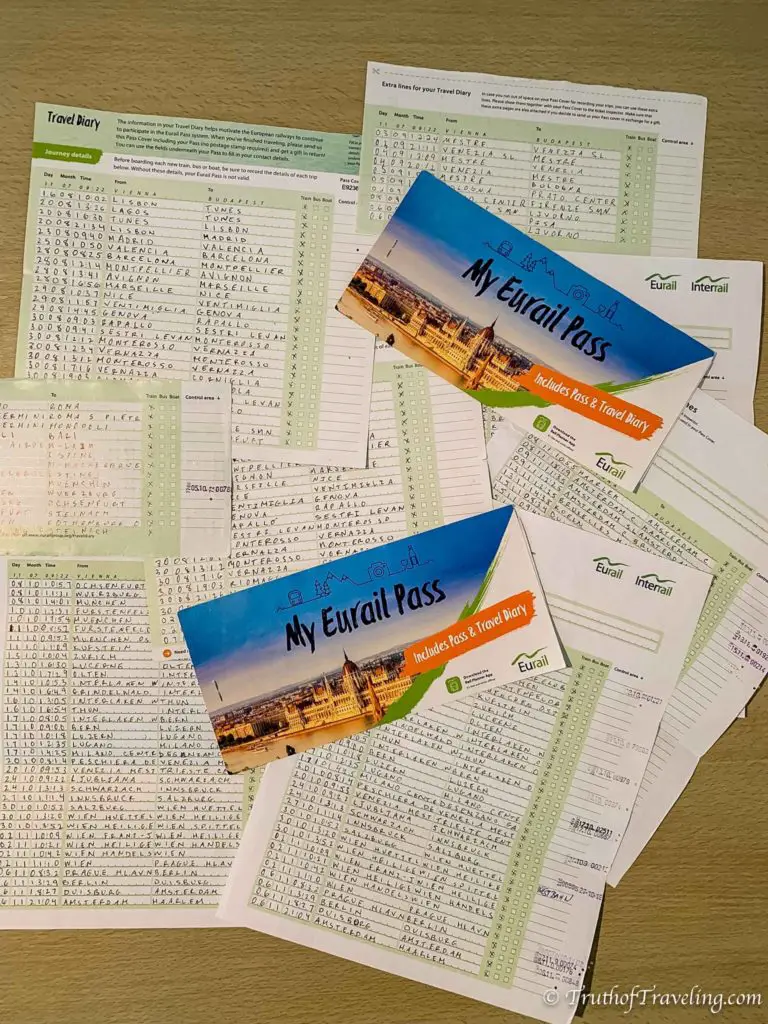
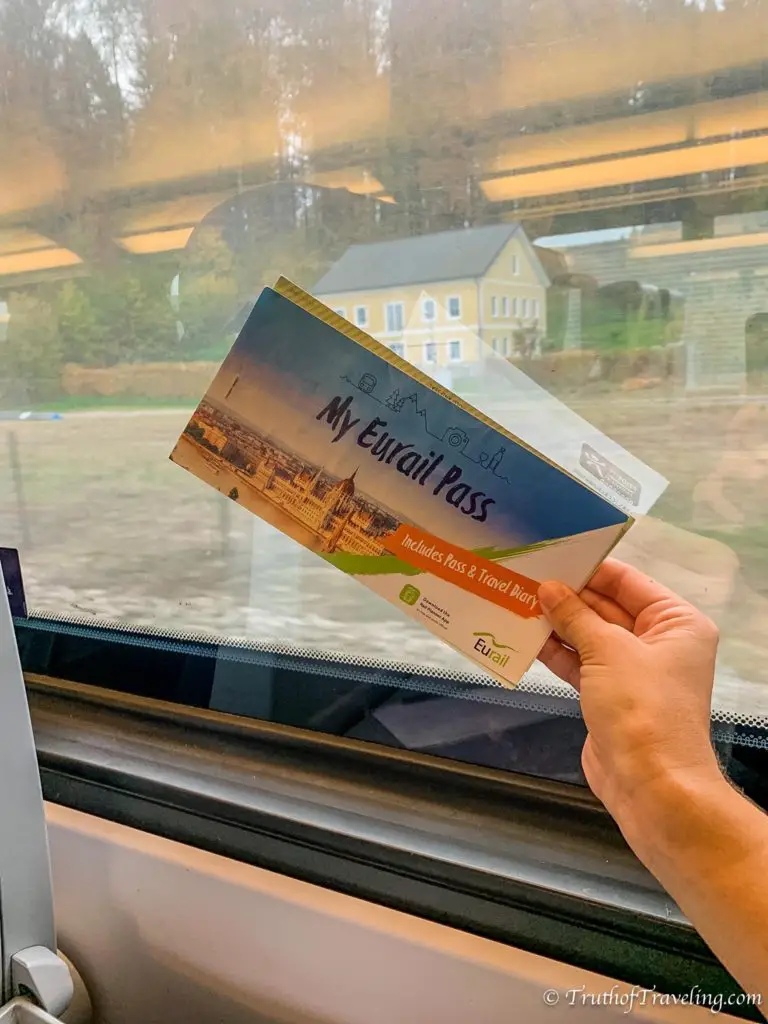
- At the end of our 3 months in Europe we had taken over 100 trains. We saved so much money by using the Eurail Global Pass instead of buying tickets separately. We were able to travel how we wanted without thinking about each individual ride counting against us.
- There are all different kinds of Eurail Passes for different amounts of time as well as for one country or just a few depending on your travel plans!
Read More: Complete Guide to Traveling with a Eurail Pass in Europe
1. Signs & Announcements are Almost Always in English
Don’t worry about not being able understand the stops or when to get off. There are almost always signs in English in the train stations so it’s very easy to understand where to go. Once you’re on the train announcements are almost always made in the language of that country and then in English. This makes it really easy to understand where you’re going and when you’re supposed to get off.
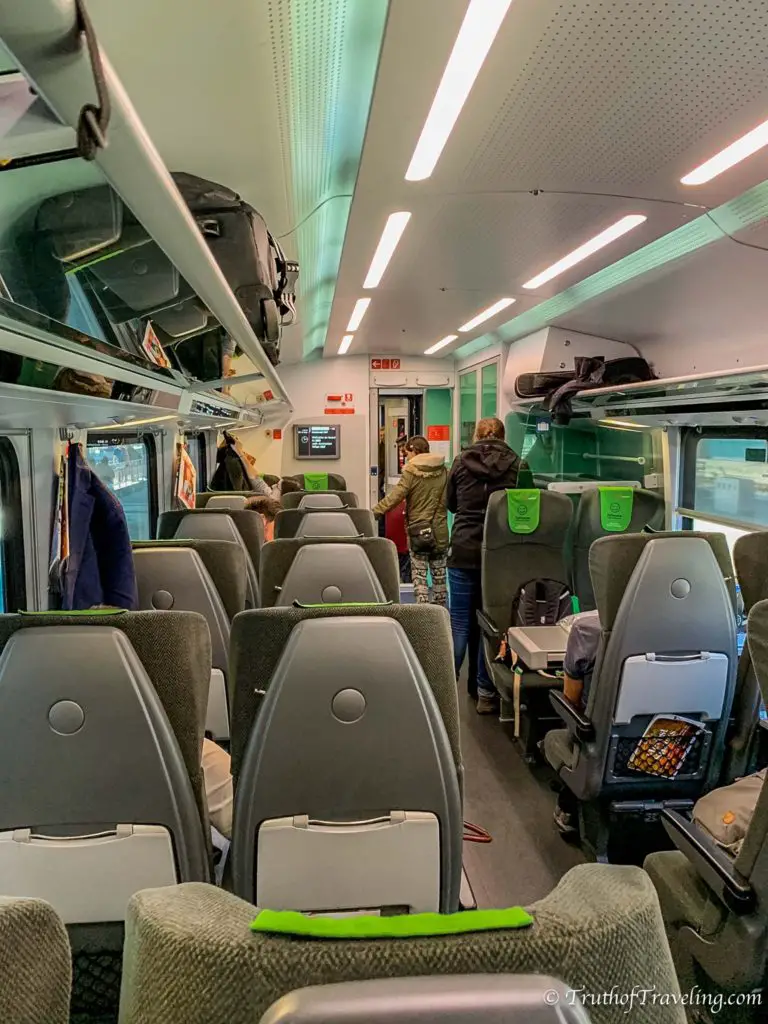

- If you’re still confused (completely understandable) we have another way to track it yourself which makes it really easy. Tip #4 on this list is a life saver and will put all your worries of missing your stop to rest!
Travel Truth: Another suggestion is to download the Google Translate app on your phone. Within the app you can actually download languages offline to use when you don’t have WIFI or phone service. We often do this so we don’t have to rely on really slow data when we’re out for the day. Download a language (or two) prior to your trip so you can look up any words you’re unsure of during your travels.
Read More: Best Apps for Traveling
2. There is Always A Paper Schedule in the Station
Some larger stations will have departures displayed on a monitor so you can find your train and the platform number that the train will be leaving from. We would recommend not waiting until the last minute to go to the correct platform because trains usually don’t stop for too long. It’s best to be waiting there ready when it arrives.
Other (usually smaller) stations have a printed paper schedule of both departures and arrivals. The two schedules are usually on different colored papers so you can tell the difference.
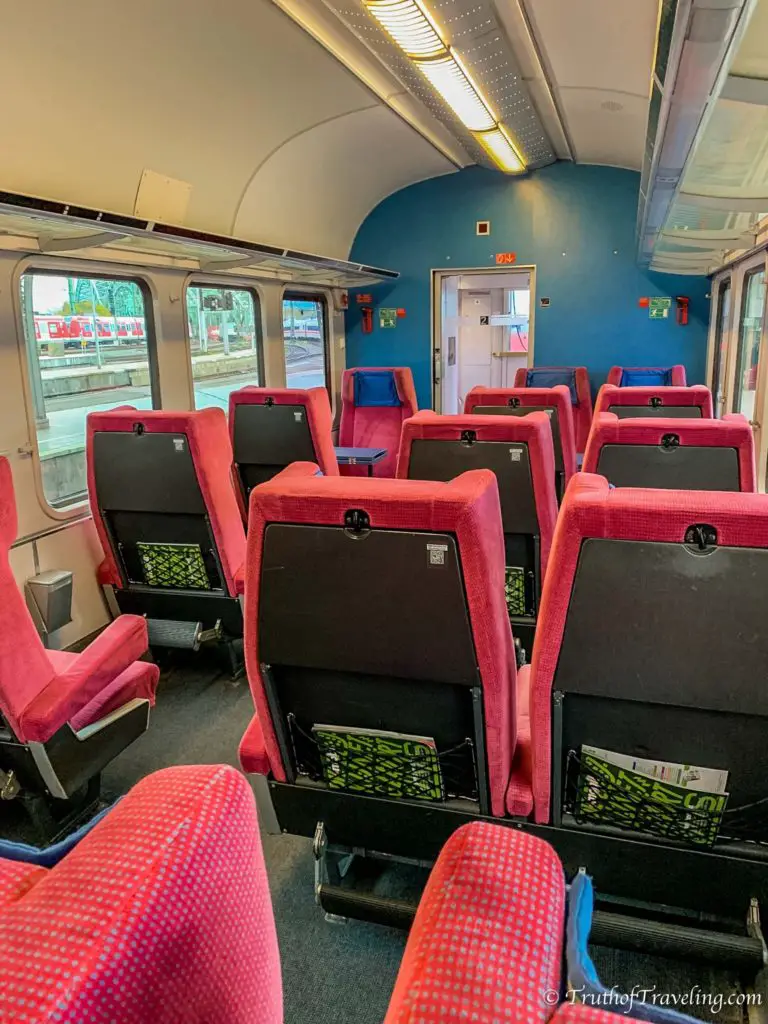
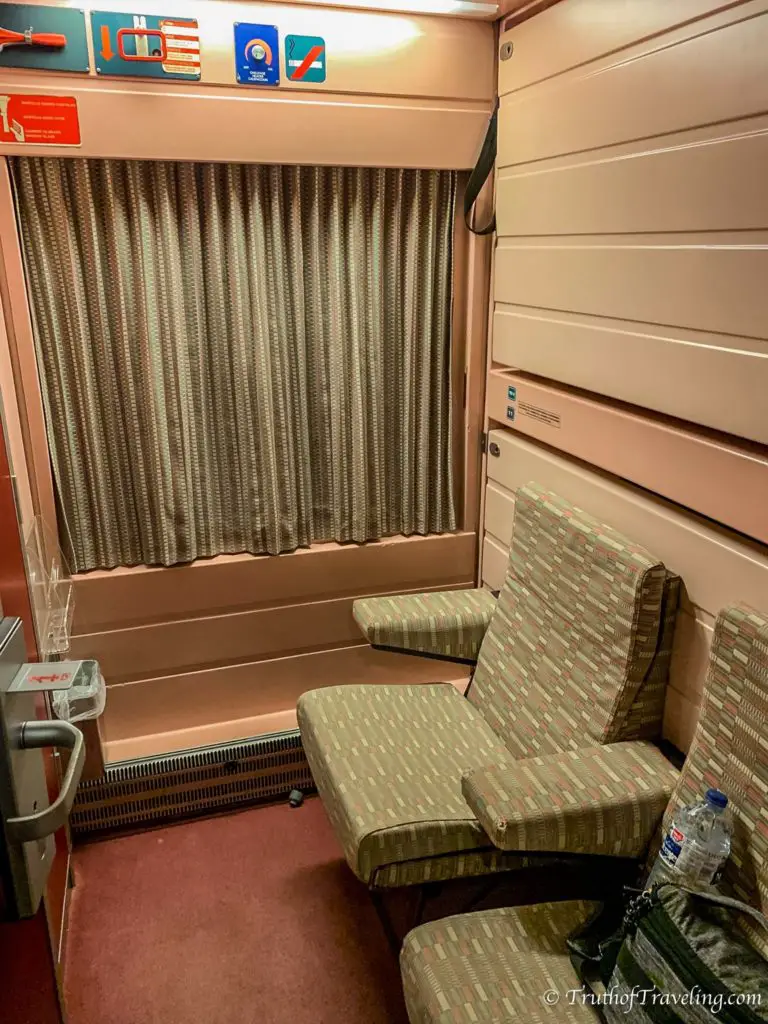
On most platforms the schedule will be in a glass case and if not on the platform then in the underground walkways. We never went to a train station that didn’t have one of these! On the printed schedule the departing trains are organized by time of departure. So if your train leaves at 9:30 start at the top of the departures schedule and find all the trains leaving during the hour 9. Then it will have a list of the stops. If you don’t see your stop don’t panic. Sometimes they list them all and sometimes they list only the larger, more major stops.
It’s REALLY helpful to know the trains end destination because that is what it’s often listed as. So for example if you’re train at 9:30 is going from Venice to Florence, the train’s final destination is probably Rome but it makes a stop in Florence where you will get off. The train will be listed as the 9:30 Rome even though your stop is in Florence.
Travel Truth: One thing we have found is that sometimes the English translation of the name is different. For example, Florence is Firenze, Wien is Vienna and Füssen is Fuessen. Just keep that in mind if you can’t find the place you’re looking for!
Read More: Guide to 15 Beaches in the Algarve, Portugal
3. Some Trains are Fancy and Some are Not But They Almost all Have a Few Things
The cleanliness and the available amenities vary widely on trains depending on things like the route, the type of train, and the actual train car you’re riding on. In general we found some of the trains we took were very clean and nice and some others were much older and not as modern. None of them were disgusting though, they all were definitely kept in good enough shape but it can vary!
The amenities on each train also differ a lot. A lot of trains in Europe are laid out with two seats facing two other seats. Sometimes you’ll find just two seats by themselves but a lot are groups of four and on the nicer trains there is a table in the middle. Almost all trains have small trash cans to throw things away. It’s actually such a good idea and something we’re not sure why trains in the US don’t have them!
- Some trains, such as high-speed trains and other newer ones, have outlets to charge electronic devices. But definitely don’t count on it all the time in every country. We always travel with a portable battery just in case there wasn’t an outlet nearby!
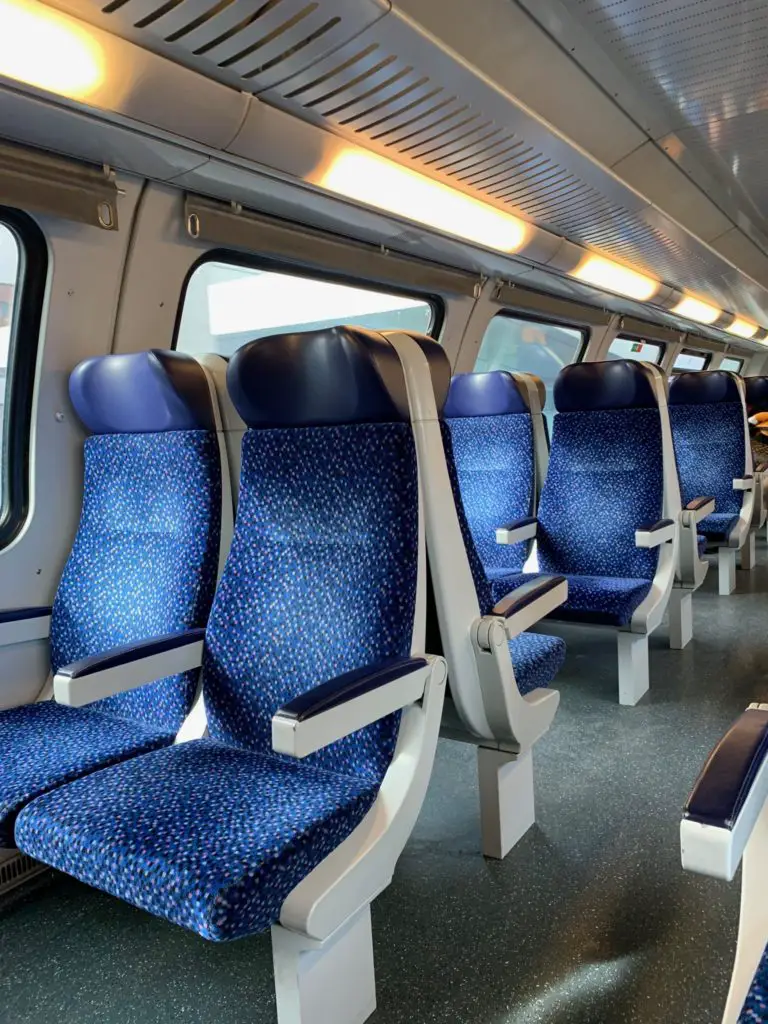
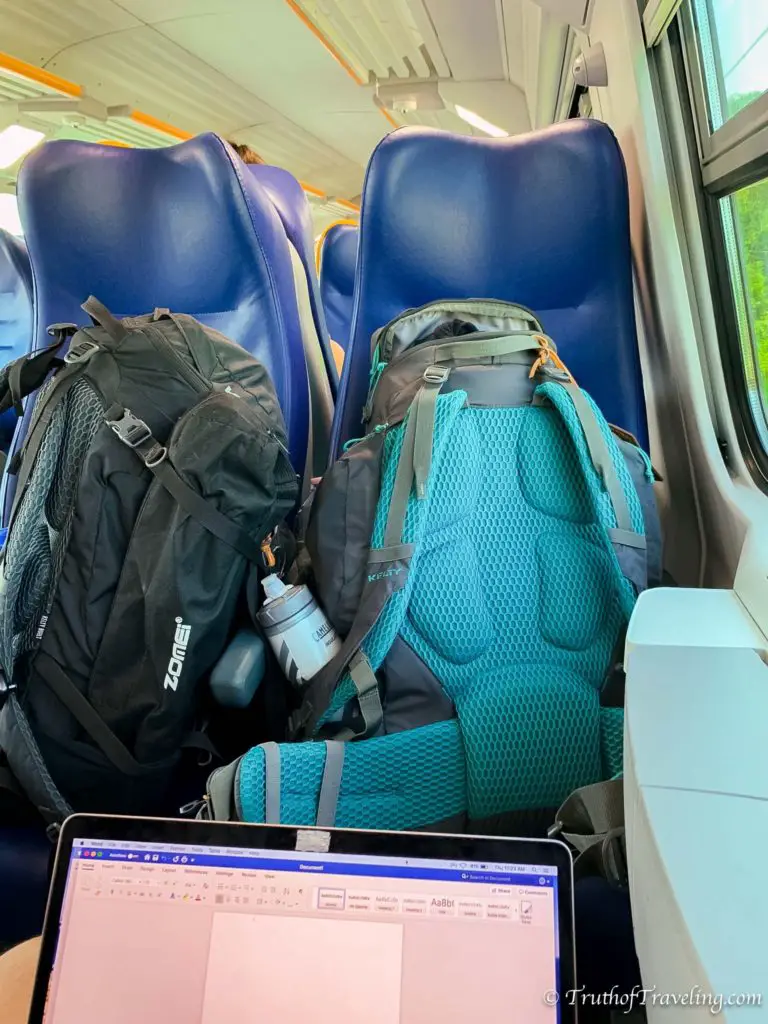
Luggage storage is something that really depends on the train car. Most of the newer, more modern ones have luggage storage above the seats similar to an airplane. Other times there will be an area at the beginning, middle or end of the car to store oversized pieces of luggage. Some of the older or smaller regional trains have a really small compartment at the top where luggage can’t possibly fit. Honestly, on some of these you’ll be lucky if you can fit a purse on the top luggage rack. We aren’t sure why they are designed that way but it’s something you may encounter!
- Sometimes there is also space in between the backs of the seats for bigger bags if the overhead space is small.
- In general don’t stress about where you’re going to put your bag too much. Once you get on the train you’ll see how it’s laid out and be able to find a spot! But it’s another reason to be on the tracks ready so you have enough time to get on, find a spot for your bag and sit down before the train leaves.
- Traveling so much on trains made us so glad we travel with carry on size bags! It was so much easier to wear our Kelty backpacks when getting on and off, finding the right platform and walking down the train aisles. We saw so many people struggling to maneuver their large suitcases on the trains.
Read More: 4 Day Guide to Visiting the Italian Riviera
4. Download the Rail Planner App
You can search for train times and schedules on the train operators website. You can then buy tickets at the train station at the ticket counter as well as automatic machines depending on the type of ticket you’re looking for.
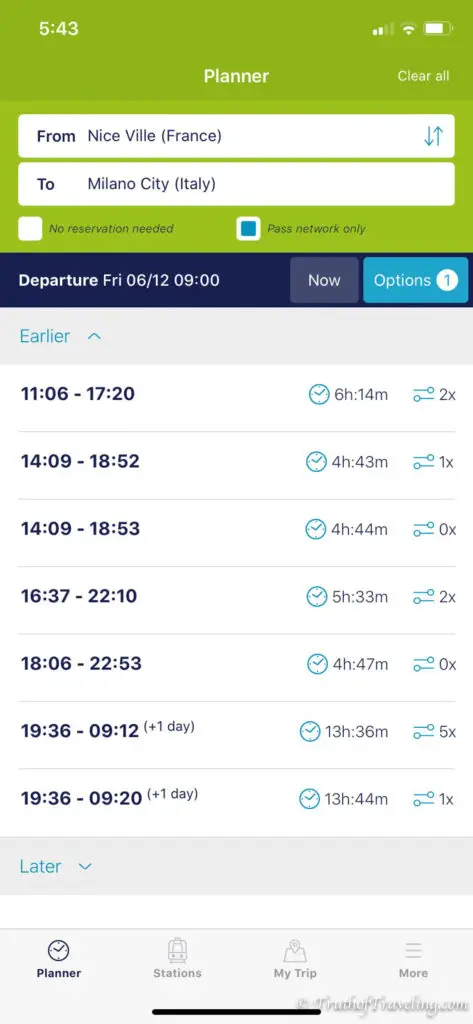
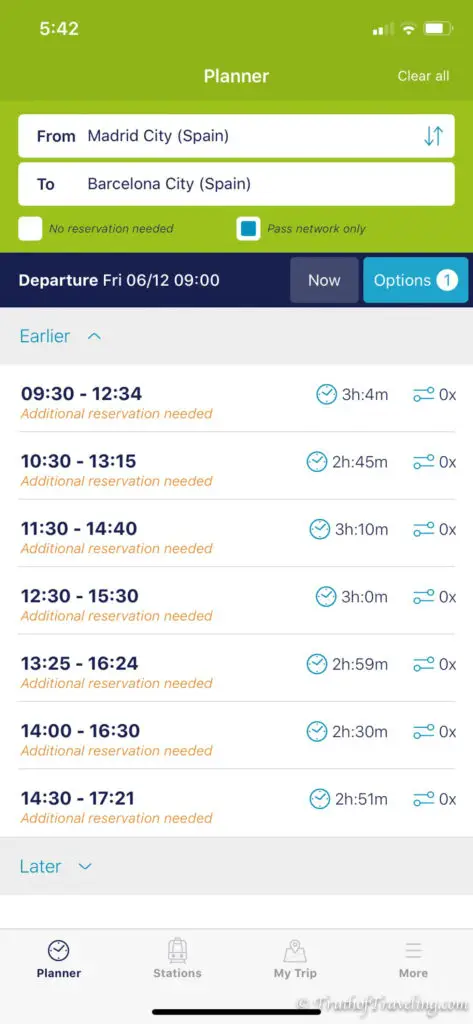
We HIGHLY recommend also downloading the Rail Planner App. It’s free to download and you don’t need to enter any information to use it. It gives you timetables, breakdown of train stops, as well as trains leaving from a certain station. You simply put in the station you’re leaving from and the station where you want to go and it gives you all the possible trains for either today or any day in the future. Plus it works offline so no need to worry about your data not working. Or if you’re at a specific station and not sure where you want to go it will give you all the upcoming trains leaving from that station.
- It also will give you the train number as well as the trains final destination so you’re able to find it and make sure its the right one at the station.
- You can save train journeys (again without logging in or anything) to track your train travels which is really cool! You can also plug in trains for days in the future when planning your travel days and which trains you want to take. Then save the journey to look back so you know when to leave!
5. Don’t Forget to Validate Your Ticket (If Necessary)
When taking trains in Europe you will often need to validate your ticket before getting on the train. This is to show that you’ve bought a valid ticket and then once at your destination, will make your ticket ineligible.
Often times there will be a small machine on the platform where you insert the end of your ticket and it validates it usually with the date and time. Other times on more regional trains you validate the ticket once you’re on the train in similar machines inside the train car.
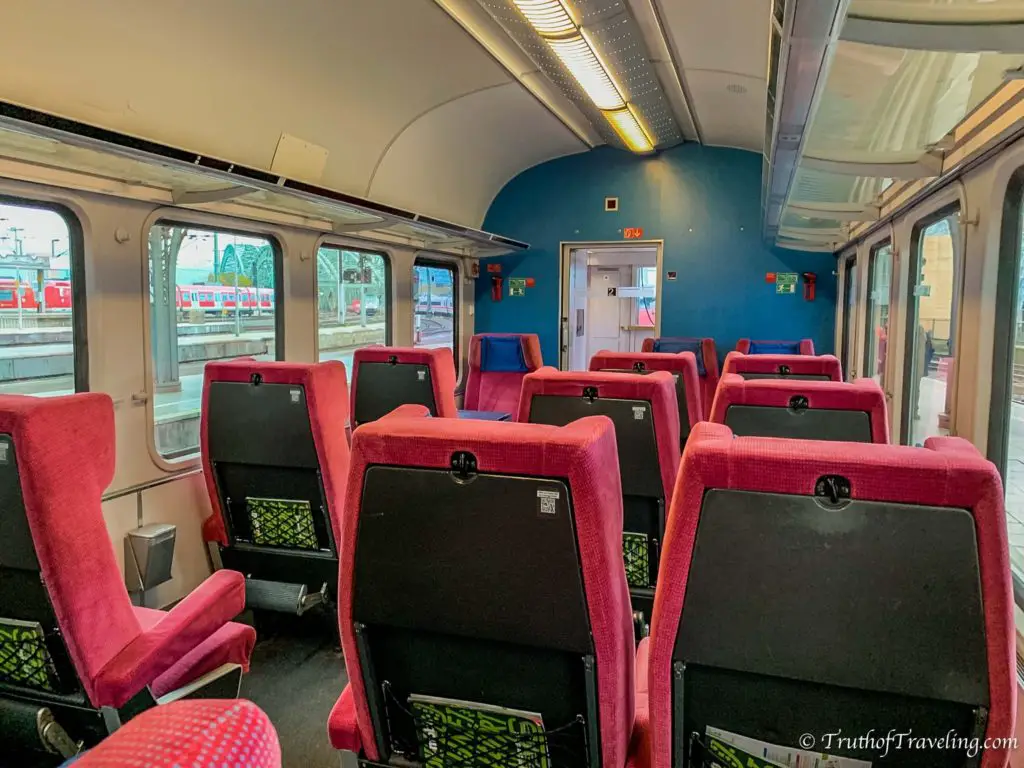

There is usually a large fine for failing to validate your ticket correctly. If you book a ticket online you usually don’t need to validate anything because it’s a mobile ticket. It’s most times when you have a physical ticket that was printed from the ticket office. It’s not required 100% of the time so just keep an eye out for any signs or validation machines on the platform or on the inside of the train car.
- Using the tram in Nice, France as well as a lot of trains in Italy require you to validate your ticket before getting on.
- If you’re traveling with a Eurail Pass you do not need to validate anything because the pass acts as your ticket.
Read More: 7 Day Switzerland Itinerary
6. Be Quick When Getting On and Off Trains
Trains in Europe usually only stop for a minute or two. Sometimes it will wait at a major stop for more like ten minutes but only in certain locations. Because they only stop for a short amount of time, it’s important to be ready and waiting! Don’t wait for the train to stop fully before getting up, gathering your things and walking to the train door. If the train only stops for 2 minutes and it takes you 4 minutes to get your bag down and get to the door you will likely miss your stop.
- Sometimes the train doors don’t automatically open at all stops. There will be a small button (or a lever on older trains) to open the door yourself.
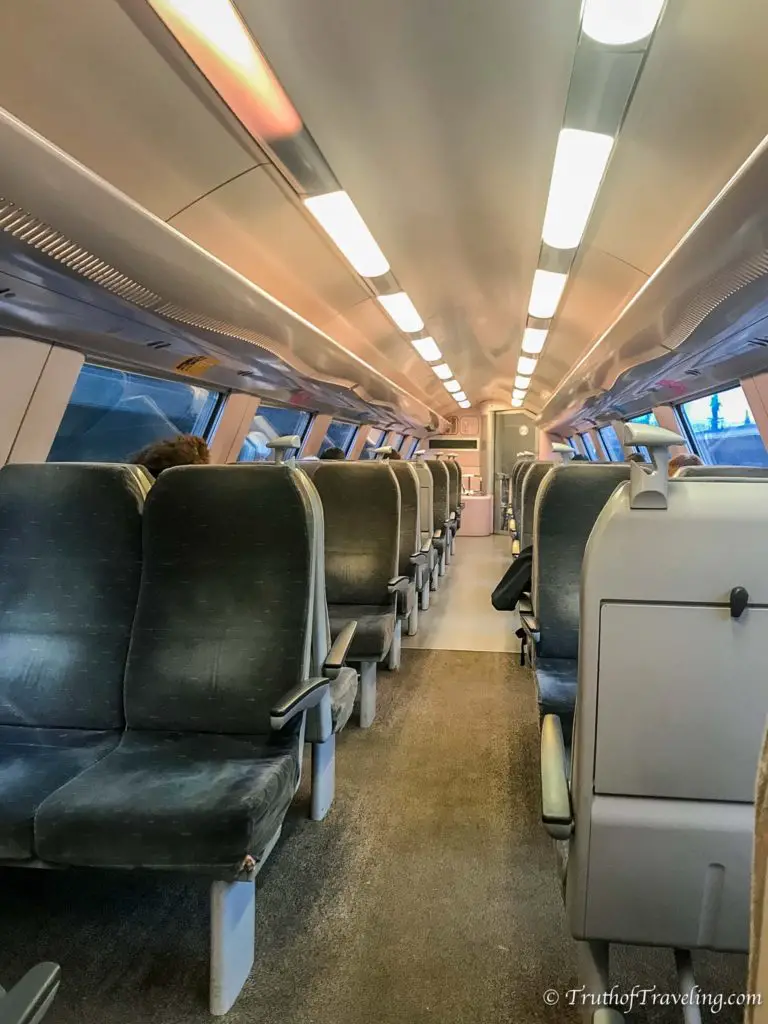
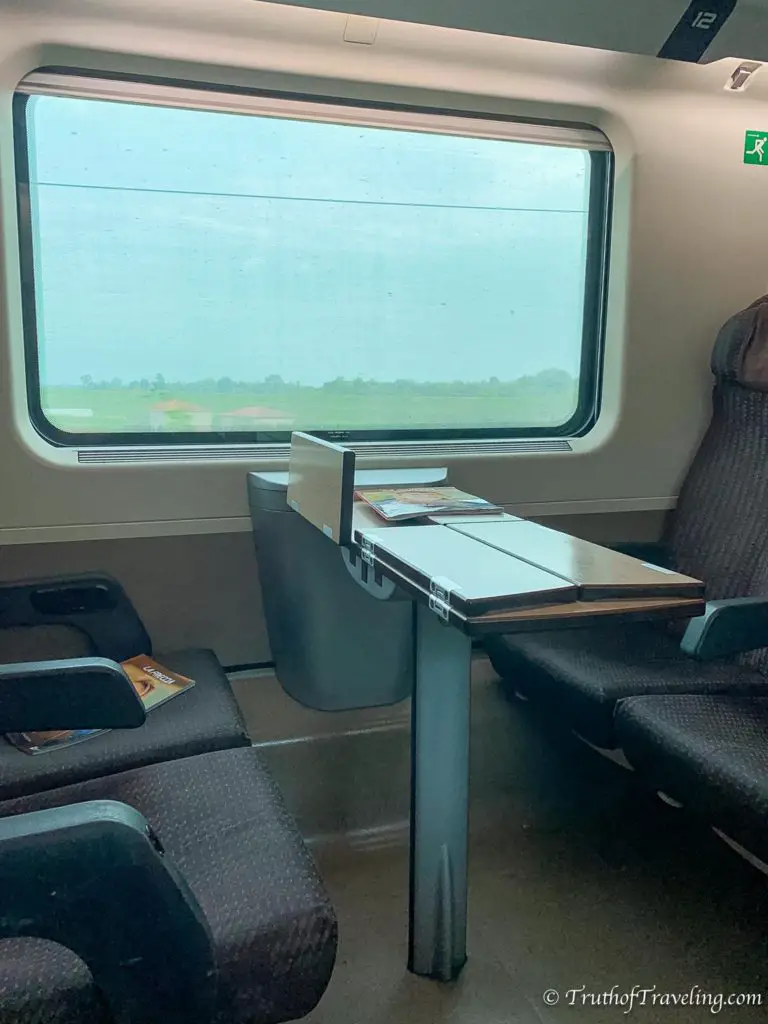
Sometimes train stops will be announced, especially major stops, and sometimes they are not. It really depends on the train and train route. Therefore don’t wait for the announcement of your stop.
- With the Rail Planner App you can follow your journey and the stops along the way to know where you are. We also tend to keep an eye out for the name of the station every few stops so we know how close or far we are from our destination.
Etiquette for trains in Europe is (usually) everyone getting off goes first then everyone getting on comes on. If you’re boarding the train stand a little to one side so everyone getting off can get by. Then everyone boarding the train will get on.
- On high-speed or longer distance trains you may notice a display above every seat. This tells you whether the seat has a seat reservation booked. It will tell you the name of the two stops in which the seat has been reserved for. Don’t worry not all trains require seat reservations!
- If you see nothing on the display it means no one has reserved that seat so anyone can sit there. Using the Rail Planner App you can look at all of the stops for that train to determine if the seat reservation was for stops prior to you getting on or after.
- Honestly though, if you sit down and someone gets on and has a reservation for that seat it’s no big deal! They will tell you it’s their seat and then you just move to the next free spot. After taking 100 trains we only had to move a handful of times!
We hope this is helpful for you whether you’re planning to take one or 100 trains in Europe! We really found them so easy to take and grew to enjoy taking European trains so much!
Interested in More Posts About Europe? Read Here!
Pin it for later:

